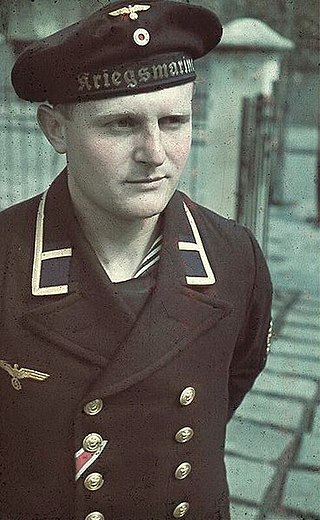
Maat is a naval rank, of German origin, used by a number of countries. The term is derived from the low German māt (comrade). Via the Dutch language, the word became a nautical term and described the assistant to a deck officer. Since the second half of the 17th century Maate were the lowest class of non-commissioned officers aboard a warship.
Gefreiter is a German, Swiss and Austrian military rank that has existed since the 16th century. It is usually the second rank or grade to which an enlisted soldier, airman or sailor could be promoted.
Feldwebel is a non-commissioned officer (NCO) rank in several countries. The rank originated in Germany, and is also used in Switzerland, Finland, Sweden, and Estonia. The rank has also been used in Russia, Austria-Hungary, occupied Serbia and Bulgaria.
Unterfeldwebel was a rank of the Wehrmacht, from 1935 until 1945. It was also used in the East German National People's Army from 1956 to 1990. The equivalent to Unterfeldwebel in the Bundeswehr of West Germany and later the Federal Republic of Germany is the rank Stabsunteroffizier (OR-5).
Stabsfeldwebel is the second highest Non-commissioned officer (NCO) rank in German Army and German Air Force. It is grouped as OR-8 in NATO, equivalent to a First Sergeant in the United States Army, and to Warrant Officer Class 2 in the British Army. Promotion to the rank requires at least twelve years total active duty, of which at least eleven years have elapsed since promotion to unteroffizier, with at least ten years since promotion to stabsunteroffizier, and nine years since promotion to feldwebel. In army/ air force context NCOs of this rank were formally addressed as Herr Stabsfeldwebel also informally / short Staber.
Unteroffizier is a junior non-commissioned officer rank used by the Bundeswehr. It is also the collective name for all non-commissioned officers in Austria and Germany. It was formerly a rank in the Imperial Russian Army.

Unteroffizier(e) ohne Portepee, is the designation for German junior non-commissioned officers (NCOs) in the German Armed Forces. The category was a division of the NCO class, separating junior NCOs from Unteroffiziere mit Portepee, or senior NCOs. The name is derived from earlier traditions in which German senior NCOs (Feldwebel) would carry the officer's sidearms with the officer's swordknot.
Fähnrich zur See designates in the German Navy of the Bundeswehr a military person or member of the armed forces with the second highest Officer Aspirant rank. According to the salary class it is equivalent to the Portepeeunteroffizier ranks Bootsmann (Marine) and Feldwebel of Heer or Luftwaffe.
Seekadett is a military rank of the Bundeswehr and of former German-speaking naval forces.
The rank insignia of the federal armed forces of the Federal Republic of Germany indicate rank and branch of service in the German Army, German Air Force, or the German Navy.
Fahnenjunker is a military rank of the Bundeswehr and of some former German armed forces. In earlier German armed forces it was also the collective name for many officer aspirant ranks. It was established by the Presidential order of the Federal president on rank insignia and uniforms of soldiers.
Oberfähnrich zur See designates in the German Navy of the Bundeswehr a military person or member of the armed forces with the last or highest Officer Aspirant rank. According to the salary class it is equivalent to the Portepeeunteroffizier ranks Hauptbootsmann (Marine) and Hauptfeldwebel of Heer or Luftwaffe.
The ranks of the German Armed Forces,, were set up by the President with the Anordnung des Bundespräsidenten über die Dienstgradbezeichnungen und die Uniform der Soldaten on the basis of section 4, paragraph 3 of the Soldatengesetz. The Bundesbesoldungsordnung regulates the salary scales of all Federal office holders and employees including soldiers. The 'ZdV-64/10 – Abkürzungen in der Bundeswehr' gives the abbreviations and a list of the abbreviations.
Oberstabsbootsmann is the highest Non-commissioned officer (NCO) rank in the German Navy. It is grouped as OR9 in NATO, equivalent to a Master Chief Petty Officer in the United States Navy, and a Warrant Officer Class 1 in the British Royal Navy.
Stabsbootsmann is the second highest Non-commissioned officer (NCO) rank in the German Navy. It is grouped as OR8 in NATO, equivalent to First Sergeant, Master Sergeant, or Senior Chief Petty Officer in the US Armed forces, and to Warrant Officer Class 2 in the British Army and Royal Navy.
Oberfähnrich designates in the Heer of the Bundeswehr a military person or member of the armed forces with the last or highest Officer Aspirant rank. According to the salary class it is equivalent to the Portepeeunteroffizier ranks Hauptfeldwebel of Heer or Luftwaffe, and Hauptbootsmann of Marine.
Stabsgefreiter is the second highest rank of enlisted men in the German Bundeswehr, which might be comparable to Corporal (OR-4) in Anglophone armed forces.
Hauptbootsmann designates in the German Navy of the Bundeswehr a military person or member of the armed forces. It belongs to the particular rank group Senior NCOs with port épée.
Oberbootsmann designates in the German Navy of the Bundeswehr a military person or member of the armed forces. It belongs to the particular rank group Senior NCOs with port epée.
Stabsunteroffizier is a military rank of the German Bundeswehr. It was preceded by the rank Unterfeldwebel that was used between 1935 and 1945 in the armed forces of Nazi Germany, the Wehrmacht. The East German National People's Army used the rank Unterfeldwebel from 1956 to 1990. In the Austrian Armed Forces Stabsunteroffizier is the collective name to all higher Non-commissioned officers.







